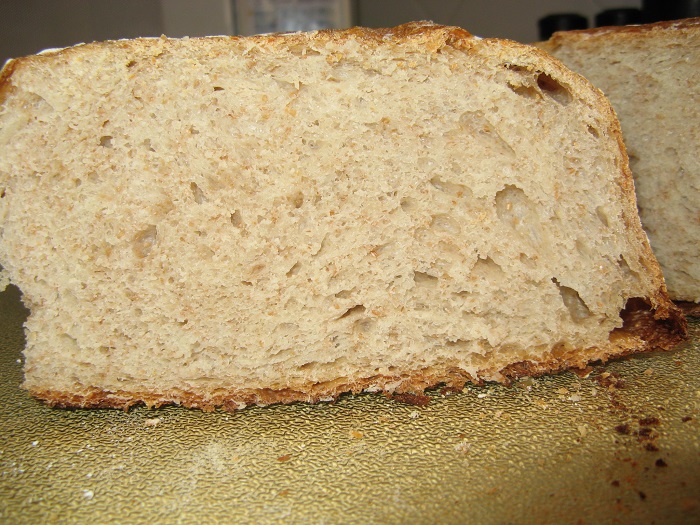The perfect opportunity presented itself this week for me to make no-measure bread. We're staying in a timeshare for a week (Lake Okanagan Resort, for those of you in BC Canada), and I was getting itchy (not baking for a week?!), plus we needed fresh bread. I wanted some fairly plain bread, nothing fancy but with a good crust and creamy open crumb, and good flavour.
So, let's see what we have on hand - an oven, mixing bowls, roasting pan, one glass measuring cup and a set of measuring spoons. Off to the grocery store to buy supplies:

AP flour, whole wheat flour and salt. Oh, and a strip of yeast packets.
I considered using some of the nice craft beer we had purchased earlier, but that was for drinking :) so on a whim I made a poolish with some leftover vanilla rooibos tea, AP flour and a pinch of yeast. Let that sit for 4-5 hours till bubbly.
I dissolved the poolish in some water (just eyeballing it), then stirred in enough WW flour for a thick batter. AP flour to turn it into what looked like an acceptable "rough shaggy mass", then worked in another pinch or two of yeast.

After an hour (it was going to be 30 minutes, but I was engrossed in the end of a good book - "The Girl on the Train" and lost track of time), work in the salt. Looks good!

Couple of stretch & folds over the next hour or two to develop and strengthen the dough -

Then in the fridge for 4 - 5 hours. I would have left it overnight but we wanted the bread for breakfast and I wasn't going to get up that early on holiday! Around 6 PM I pre-shaped, then shaped the boule. The dough felt nice, fairly slack and satiny but with enough body to work with. It did have quite a few large bubbles that needed popping and deflated a fair bit on the shape. After shaping I popped it into a Pyrex bowl lined with a floured dish cloth, then put the whole thing into a plastic bag to proof for a couple of hours, poking it every now and then. Dough was strong and rose well.
Now comes the challenge - how to get a nice crust? I could have used the roasting pan for a steam tray, but decided to use the bottom of it as a baking tray and invert one of the Pyrex glass bowls over the top. Unfortunately, the oven spring was so good the dough filled the bowl after about 15 minutes! I needed to take the whole thing out of the oven and pry the bowl off the loaf, then put it back in to finish. Oh, original oven temperature was 475F, then down to 425F after five minutes for the rest of the bake. Total time was around 40 minutes (15 to 20 in the bowl, then another 20).

After baking, I was pretty happy with the 'sing' - the crust just crackled away merrily for about 5 minutes after taking it out of the oven! Really lovely crust, but no scoring (no good knife, plus jamming itself into the bowl negated any possible burst at the seams). Despite being distinctly bowl-shaped I was quite happy with it.

This morning we cut the loaf. It was excellent really - the crust was very crispy and the crumb moist and a bit gelatinized. Lovely flavour, though I must admit I had the first couple of slices with PBJ and then some more with cheese, so I probably missed any subtle flavour from the vanilla rooibos tea in the poolish. Maybe later. :)


All in all, I feel like a real baker now. Everything was by feel or 'eye', nothing measured or weighed and no taking of temperatures (just the old thump test). And it turned out very good!